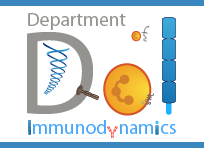Focal recruitment of neutrophils (red) to glomeruli (blue)
Blood vessels in the urinary bladder
Neutrophils (red) and Macrophages (green) communicate to phagocytose Debris
Spatial distribution of Neutrophils (red) and Macrophages (green) in the inflamed skin
Cellular crosstalk of macrophages and neutrophils
Neutrophils are continuously generated within the bone marrow by myeloid precursors and their half-life is limited to a few hours. Their main function is to patrol vessels and vigilantly seeking out for indications of an incipient inflammation. Recruitment of neutrophils is induced by stimuli, such as chemokines, leukotrienes and formyl peptides. Interstitial migration seems to be facilitated by integrins, actin polymerisation, chemokine receptors, TREM-1 expression and Matrix Metalloproteinases. Once recruited from the bloodstream, neutrophils cross the dense macrophage network and acquire essential properties for optimal anti-microbial defence. Our aim in to understand neutrophil migration under inflammatory conditions.
Research focus
